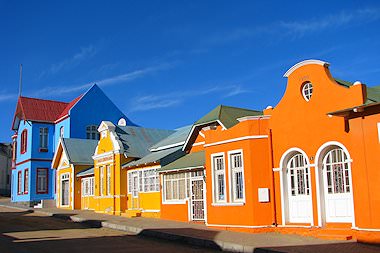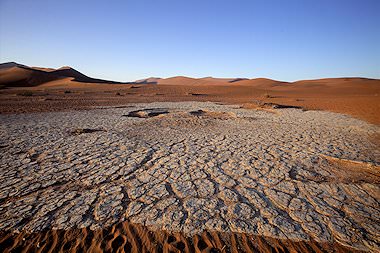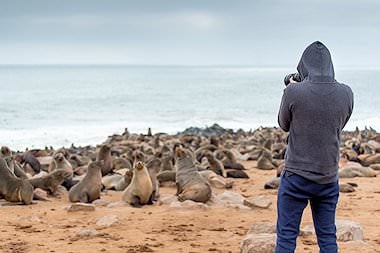Namibia's Namib Desert
Help Me Plan- Home
- >
- African Travel
- >
- Namibia
- >
- Namib Desert
Namib Desert Destination Guide
The Namib is Earth’s oldest desert, a living museum of wind-sculpted dunes, fog-fed life and cinematic horizons. Here you’ll find Sossusvlei’s towering dunes, the stark Skeleton Coast, granite massifs, Welwitschia, San rock art and desert-adapted wildlife like gemsbok and elephant—an otherworldly stage for photography, stargazing and quietly profound wilderness experiences.
Getting to the Namib Desert
By Air: Guests traveling to the Namib Desert are welcomed at OR Tambo International in Johannesburg and assisted in boarding a flight to Hosea Kutako International Airport in Windhoek. Upon arrival, guests will board a light charter flight to Swakopmund or a commercial flight to Walvis Bay, depending on your first destination within the Namib Desert.
By Road: Traveling through the Namib can be a daunting experience, but not when traveling with African Sky. An expert guide will transport guests in a private, air-conditioned 4x4 vehicle. If you are visiting various destinations in the Namib expanse, you will be chartered on a light aircraft over longer distances to ensure your comfort.
Weather & Best Time To Visit
The Namib Desert covers a vast expanse with varying climates. The coastal climate is mild throughout the year, while inland temperatures vary drastically. The coastal regions are characterized by rolling fogs and are a regular phenomenon. The mist is further pressed inward by strong winds from the Atlantic.
The inland areas have sweltering summers, mild winter days, and freezing winter nights. It is better to go to the Namib during the winter. Although this is the dry season, the temperatures are more comfortable compared to the summer daytime temperatures that easily exceed 45°C. The pans are exceptional in winter and summer, depending on what you wish to see.

The plants of the Namib have adapted to this barren area. A variety of animals, such as gemsbok, springbok, zebra, ostrich, and jackal, are found on the plains and dunes of the Namib Desert. Hyena, elephant, rhino, lion, and jackal inhabit the northern areas. The outer parts of the dunes have an abundance of gecko, insect, and snake but almost no mammal.
Best Private Tours and Safari Packages
Enjoy a safari in Etosha National Park, climb the towering dunes of Sossusvlei, or take in panoramic views at Fish River Canyon, all while staying in uniquely designed desert camps and African-styled safari lodges.
Experiencing the Namib Desert is a focus of this fourteen-day private overland tour of the highlights of Namibia.
Sossusvlei and parts of the desert south of this iconic destination are explored in the company of a private African Sky guide.
Visits to Swakopmund and the Skeleton Coast north of the town are the highlights of this short vacation in Namibia.
Recommended Lodges and Hotels
The Namib Desert covers an immense area and offers visitors unique accommodations in otherworldly settings.
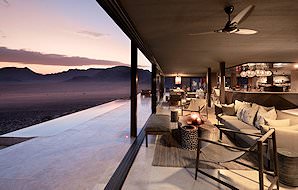
Sossusvlei Desert Lodge
Sossusvlei Desert Lodge offers luxury accommodation, sweeping views of ancient mountains, a dune sea, and a night sky you will see brighter almost nowhere.
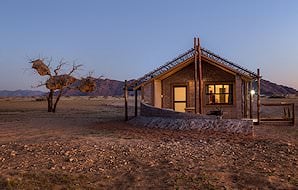
Sossusvlei Desert Camp
Desert Camp offers comfortable self-catering accommodation near Sossusvlei. All twenty-eight units provide en-suite bathrooms and a verandah.
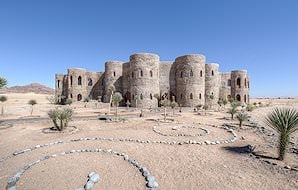
Le Mirage
Le Mirage is a unique property about 85 km from Sossusvlei built on a desert plain with exceptional views of the surrounding landscape. It offers all amenities.
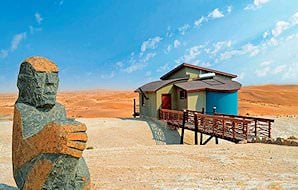
Desert Breeze Lodge
Desert Breeze Lodge is a stone's throw from central Swakopmund. The vivid colors of the lodge create a stark contrast with the surrounding desert landscape.
Reasons to visit the Namib Desert
Best Ballooning
The Namib Desert is one of the most stunning places to go hot air ballooning. The vastness of the expanse can only be fully comprehended when you see it from the skies. Take an early morning trip as the sun rises over the sandy dunes of the desert, and see the landscape transform in front of your eyes.
Grab a board
It has some of the world's highest dunes, with several peaks exceeding 300 m. Various operators in the area offer adventure activities on the dunes, of which the most renowned is sand boarding. Strap in and enjoy the ride as you kick up sprays of sand. Remember, however, sand boarding is not snowboarding, so take care to follow the instructions.
Shoot for the Stars
The largely uninhabited, untouched landscape of the Namib, combined with extremely low rainfall and frequent coastal fog, means that the sky is remarkably dark. Nearby, the NamibRand Nature Reserve is an official International Dark Sky Reserve, celebrated for exceptional stargazing conditions.
Experiences to Savor
The fascinating experiences in the Namib Desert range dramatically in their scope of focus, from the minute, desert-adapted creatures that you should keep an eye out for to the vast open spaces that will take your breath away.
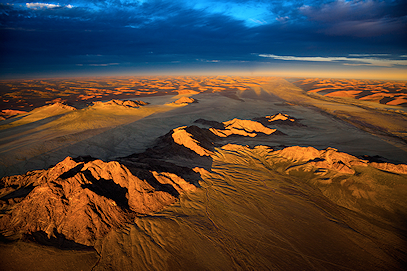
Open Spaces
The desert is largely uninhabited. Here you can get lost in the boundlessness of a vast expanse that stretches before you from one point of the horizon to another. It is daunting, yet there is an inherent sense of freedom.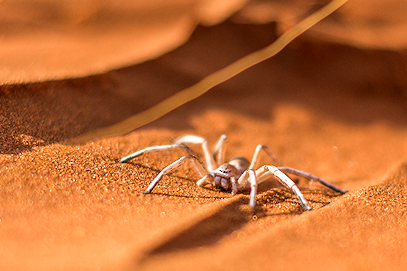
Extraordinary Adapters
Although there aren't many who call the Namib Desert home, those who live here have adapted to the harsh climate by adopting peculiar habits. Learning from the locals about their way of life is an honor and a treasure to cherish forever.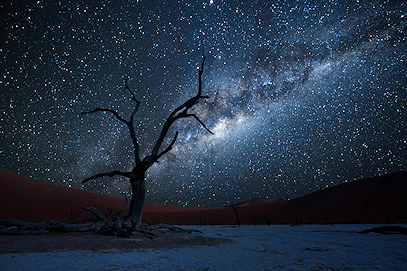
Desert Sky
Throughout the day, the scorching sun brings no relief to those visiting the Namib Desert, and the hope of rain is non-existent. At night, however, when you look at the stars, the sky seems to smile down upon you with the brightest smile it can give.Useful Information
History
The Namib Desert is the oldest in the world. It has been an arid environment for the last 55 million years. These conditions were brought about by the continental split of west Gondwana 130 to 145 million years ago, and the area that is now the Namib Desert moved north toward the Tropic of Capricorn. Because the region's climate remained stable for such an extended period, it allowed for an evolutionary environment specific to arid environment species found nowhere else on earth. Fog constantly forms as cold air brought about by the Benguela Current, and warm air from the Hadley Cell collide. As a result, the coastal region experiences frequent fog each year.
The constant coastal fog has been disastrous for ships and caused many to meet their end here. The Skeleton Coast gets its name from these wrecks that litter the landscape. This unforgiving, arid environment has seen very little human habituation over time. Stone tools and some rock art indicate that Stone Age Bushmen that followed a hunter-gatherer lifestyle once occupied the area. Even today, very few people live here. There are only some small scattered settlements of pastoral groups like the Topnaar Nama in the central region and Ovahimba and Obatjimba Herero in the north.
Wildlife
Due to the unmatched age of the desert, it is the home of more endemic animal species than any other desert in the world. An example is an endemic darkling beetle that survives by capturing morning fog with bumpy elytra that consist of hydrophilic bumps and hydrophobic troughs; droplets roll to the mouth. Another endemic darkling beetle, known only by the scientific name Lepidochora discoidalis, builds webs to trap fog.
The coastline seasonally produces large amounts of prey in the form of Cape fur seal during the pupping season. Predators include leopard, lion, black-backed jackal, and brown hyena, with some spotted hyena in the east. Cape fur seal provides abundant prey only during the breeding season; other prey species include springbok, steenbok, klipspringer, chacma baboon, feral horse, and gemsbok. Predators here has also adapted to eat insect and fruit to survive. Desert bird species attract birders from far and wide. Bird one might find here include Herero chat, Karoo lark, lesser honeyguide, and Karoo eremomela.
Vegetation & Terrain
The Namib is described as the only true desert in Southern Africa. It is understandably not particularly famous for its diversity in terms of vegetative species. The desert is, however, known for unusual flora and enchanting terrain. One of the prominent features of the area's geology is the sand seas on the coast. With dunes that reach 300 m in height and span 32 km, these are some of the largest dune fields in the world. Moving away from the Atlantic Coast, the desert transforms into dry, cracked plains and stone mountains. It covers an area of more than 80 000 km2, larger than some countries, including Ireland, and is almost twice the size of Switzerland.
After the rainy season, in the inland mountains, you can find several temporary rivers in the Namib. However, they last only a short time, and most never make it to the coast. Upon exploring the area, you are sure to find some plants whose sheer will to survive and method of survival will surprise you. For example, the Welwitschia mirabilis only produces two leaves that grow endlessly along the ground and can become thousands of years old. The camelthorn tree also plays a vital role in providing shade for other plants and animals—especially nesting bird during the spring—and for seed distribution. It is remarkable to see how the vegetation has adapted to survive.
Activities
When visiting the oldest desert in the world, you will find a surprisingly large amount of things to do and places to see. It is almost impossible to comprehend the immense vastness of the Namib, and the closest you will get to understanding its enormity is by taking a hot air balloon ride. You will not regret a single second. If this doesn't make you feel small, looking up at the night sky on one of the many cloudless evenings is a sure cure. Sossusvlei offers exceptional stargazing; nearby, the NamibRand Nature Reserve is a certified International Dark Sky Reserve.
If you're attracted to the coastline or have an interest in seafaring, you must make your way to the Skeleton Coast, named after the multitude of ships that met their end here due to the fog-riddled climate. Wherever you travel along the Namib, be sure to take your camera, as the various landscapes are mesmerizing. There are also many types of safaris offered in the region, such as 4x4, boat, or walking safaris. For the more adventurous spirits, quad biking, horse riding, dune boarding, skydiving, and surfing are available and are sure to get the heart racing.

